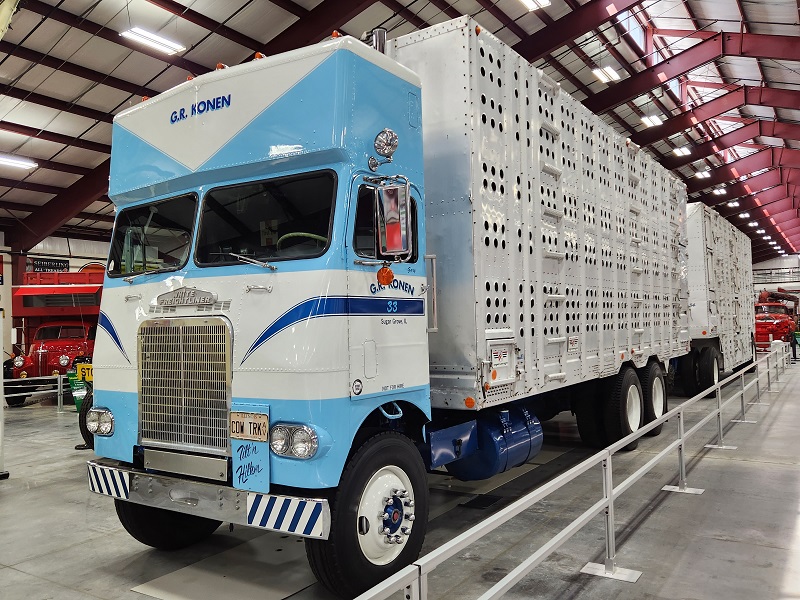
Trucks on Display
Below is a sampling of the many trucks on display in our Trucking Hall of Fame® Exhibit Hall. Check out our app for more information, photos, and an audio recording for each truck. Click here to download.

1966 Freightliner WFT
Engine Type:
318 Detroit Diesel
Transmission Type:
4-Speed Roadranger w/ 4-Speed Spicer Auxiliary
Truck Information:
In 1966, truck length regulations were in full force in California. Bumper to bumper length could not exceed 55 feet and space was at a premium. It was these regulations which gave rise to this unusual truck. Potentially one of the narrowest cabovers ever produced at only 48 inches from bumper to the back of the cab, the small size of the cab allowed drivers to maximize their loads while remaining within the stringent regulations. The sleeper bunk was placed on top of the cab so as not to add unnecessary width. This specific body style is very rare. It is speculated that only 3,000 - 6,000 were ever produced, and it is unknown whether any other examples have survived to the present. The truck was ordered from Freightliner by cattle shipping company Marcel based in Oregon. Several years later the truck was sold to Wagner Transportation in Idaho, the largest dealer of Wilson Trailers in the United States. Wagner used the truck to transport their inventory. Eventually the truck made its way to enthusiast Gary Konen who restored the truck to its former glory. This truck features a trailer arrangement which may seem unusual to those of us from the Midwest, although it is still used in some applications. One trailer is mounted directly on the chassis of the truck, while another short trailer is pulled by a hitch behind the first. This arrangement is called a straight truck and pup. Pup trailers present several advantages over traditional semi-trailers. They are much more maneuverable, allowing drivers to navigate tight turns which would be impassable with a traditional trailer. In some cases, the additional trailer axles allowed drivers to circumvent restrictive weight limits. Livestock haulers on the West Coast liked these kinds of trailers because, if forced to drive down an unpaved fireroad, the driver could leave the pup and continue onwards. After reaching their destination, the driver would unload the box mounted on the chassis, return to the pup, fill the box again, and head back to the destination. Although this process was time consuming, a truck with a full-length trailer wouldn’t be able to make it at all!
318 Detroit Diesel
Transmission Type:
4-Speed Roadranger w/ 4-Speed Spicer Auxiliary
Truck Information:
In 1966, truck length regulations were in full force in California. Bumper to bumper length could not exceed 55 feet and space was at a premium. It was these regulations which gave rise to this unusual truck. Potentially one of the narrowest cabovers ever produced at only 48 inches from bumper to the back of the cab, the small size of the cab allowed drivers to maximize their loads while remaining within the stringent regulations. The sleeper bunk was placed on top of the cab so as not to add unnecessary width. This specific body style is very rare. It is speculated that only 3,000 - 6,000 were ever produced, and it is unknown whether any other examples have survived to the present. The truck was ordered from Freightliner by cattle shipping company Marcel based in Oregon. Several years later the truck was sold to Wagner Transportation in Idaho, the largest dealer of Wilson Trailers in the United States. Wagner used the truck to transport their inventory. Eventually the truck made its way to enthusiast Gary Konen who restored the truck to its former glory. This truck features a trailer arrangement which may seem unusual to those of us from the Midwest, although it is still used in some applications. One trailer is mounted directly on the chassis of the truck, while another short trailer is pulled by a hitch behind the first. This arrangement is called a straight truck and pup. Pup trailers present several advantages over traditional semi-trailers. They are much more maneuverable, allowing drivers to navigate tight turns which would be impassable with a traditional trailer. In some cases, the additional trailer axles allowed drivers to circumvent restrictive weight limits. Livestock haulers on the West Coast liked these kinds of trailers because, if forced to drive down an unpaved fireroad, the driver could leave the pup and continue onwards. After reaching their destination, the driver would unload the box mounted on the chassis, return to the pup, fill the box again, and head back to the destination. Although this process was time consuming, a truck with a full-length trailer wouldn’t be able to make it at all!
< Return To Truck List

